The town of Demmin is one of the Hanseatic cities of Mecklenburg-Vorpommern, and there are several sights in the city from its history as a fortified commercial center. Today, more than 10,000 inhabitants live in Demmin, and the central square is Markt.
Markt is the market square in Demmin, and it is a good starting point for a walk in the streets. Do enjoy the elegant city hall before you continue to the great St. Bartholomew’s Church and the maritime environment at the previously very busy river port, which was the reason for much of the development of Demmin.
Demmin is not the only Hanseatic city in the region, so there are nice options for day trips, i.e. to Greifswald and Anklam, but also to the larger city of Stralsund. You can also enjoy the lovely beaches on the Baltic Sea as well as some museums and cozy towns.
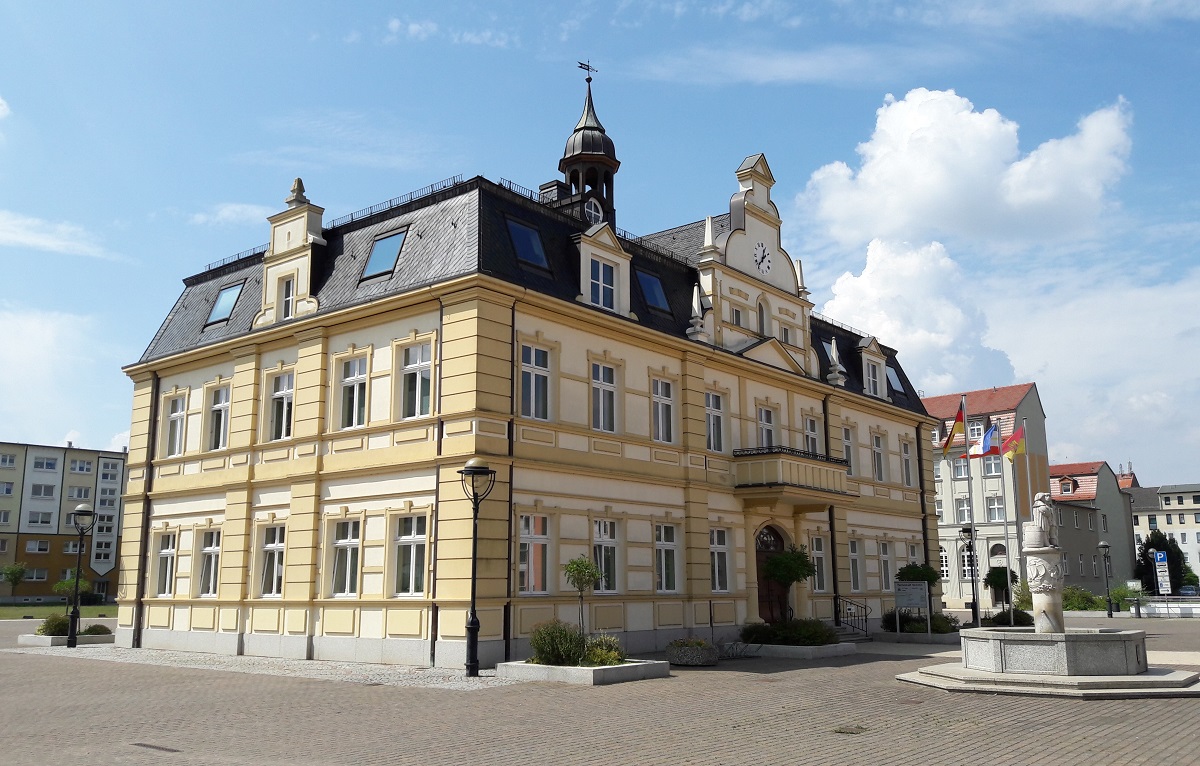
The city hall in Demmin is probably the city’s most elegant building. The current building was inaugurated in 1998 as a reconstruction of the town’s 18th-century town hall, which was constructed in the baroque period. The town hall burned in 1945, and a proposal for reconstruction was made after 1945.
The first town hall in Demmin was built in the 13th century in a time where the town obtained market town rights. The town hall was built in the Gothic style and rebuilt several times over time.
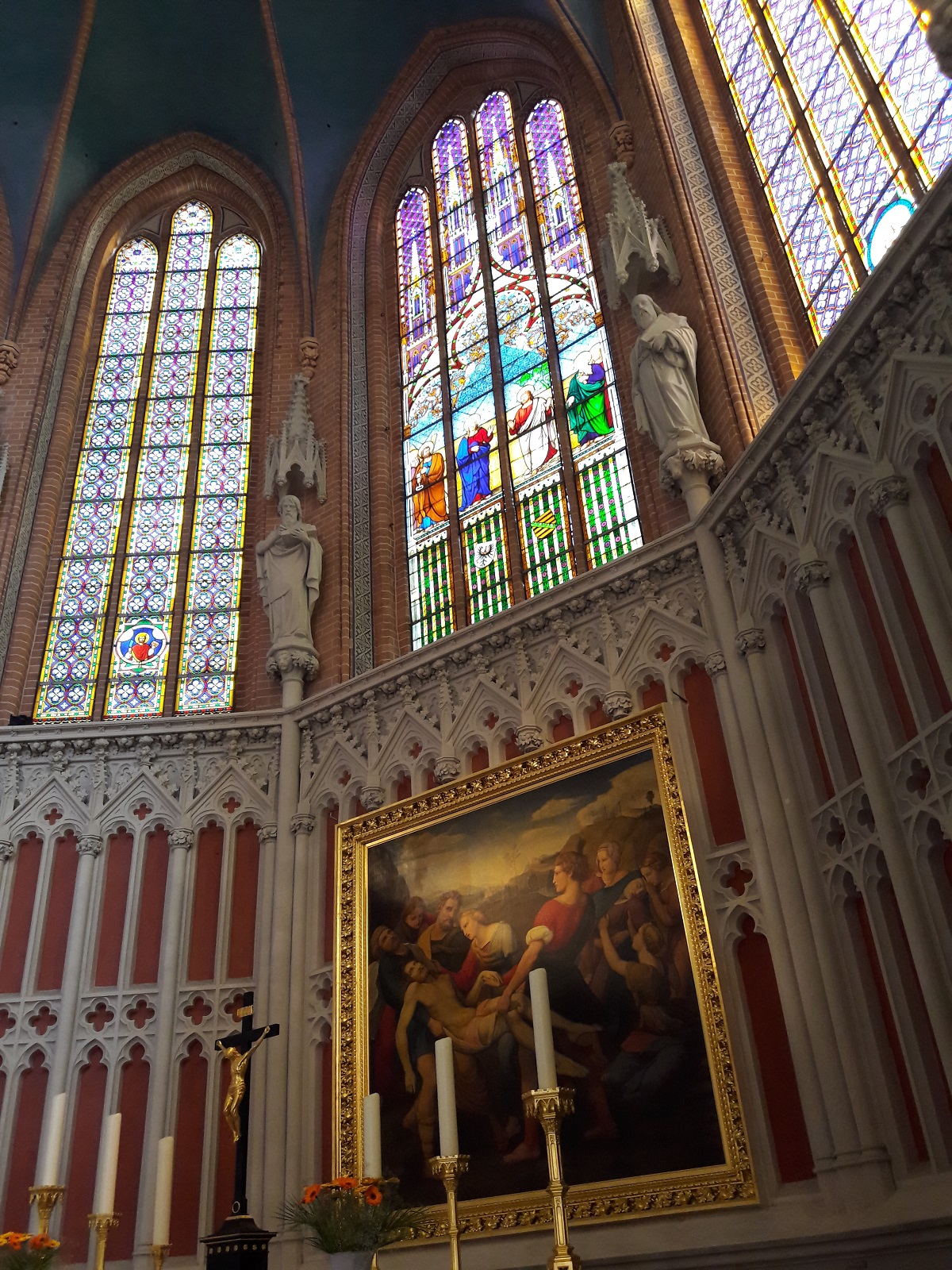
St.-Bartholomaei-Kirche is a grand church that stands as Demmin’s dominant structure, which can be seen from afar in the city’s skyline, since the church’s tower reaches a height of over 95 metres.
The church is a three-nave Gothic building from the 13th century. The first version of the church was consecrated in 1260, and over the years it has been continuously expanded, destroyed and rebuilt repeatedly. In recent centuries, the church was hit by the devastating fire that ravaged the city in 1676 during battles between Brandenburg and Sweden.
The current church is particularly beautifully restored, and it is the result of a thorough reconstruction that was carried out in the years 1856-1867. The high tower is the most tangible structure from this time, but the interior of the church is also worth seeing. In the choir you can enjoy Karl Gottfried Pfannschmidt’s beautiful stained glass windows, and in the church you can also see a depiction of Bishop Otto von Bamberg’s mission to Demmin in 1128.
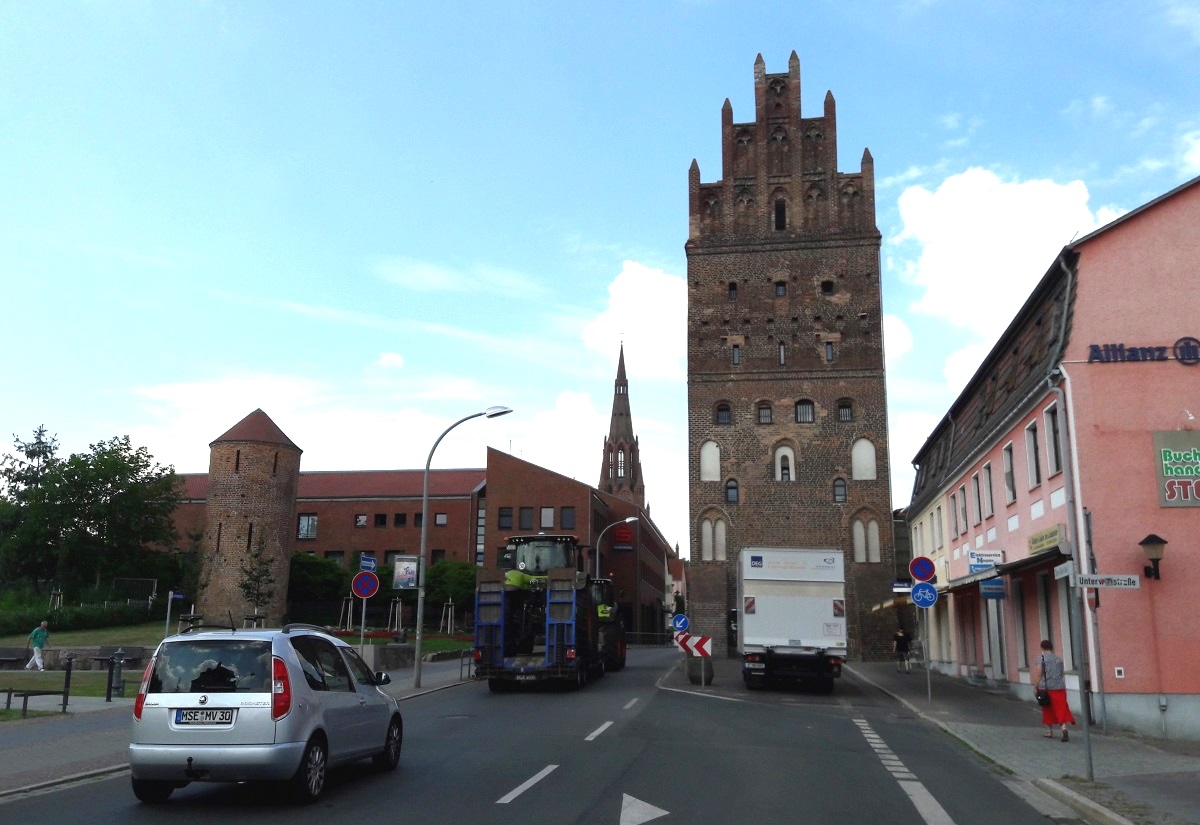
Luisentor is Demmin’s only remaining city gate from the city’s medieval fortifications. The 31 meter high gate was built in the 13th century at the same time as the city walls, which formed the defense of the city centre. During the period spanning 1768-1895, the gate also functioned as a prison.
The gate was called Kuhtor until 1821, and it was Demmin’s defense gate to the east and at the same time the most important of the city’s gates, since there was no natural defense in the form of the surrounding waterways in this direction.
Demmin’s medieval fortification consisted of a wall around the city. There were a total of 27 gates and towers along the wall, and in addition to the eastern Kuhtor, the gates were named Frauentor, Schloßtor, Fischerpforte, Kahldentor, Holstentor and Mentzerpforte in that order clockwise from the Kuhtor.
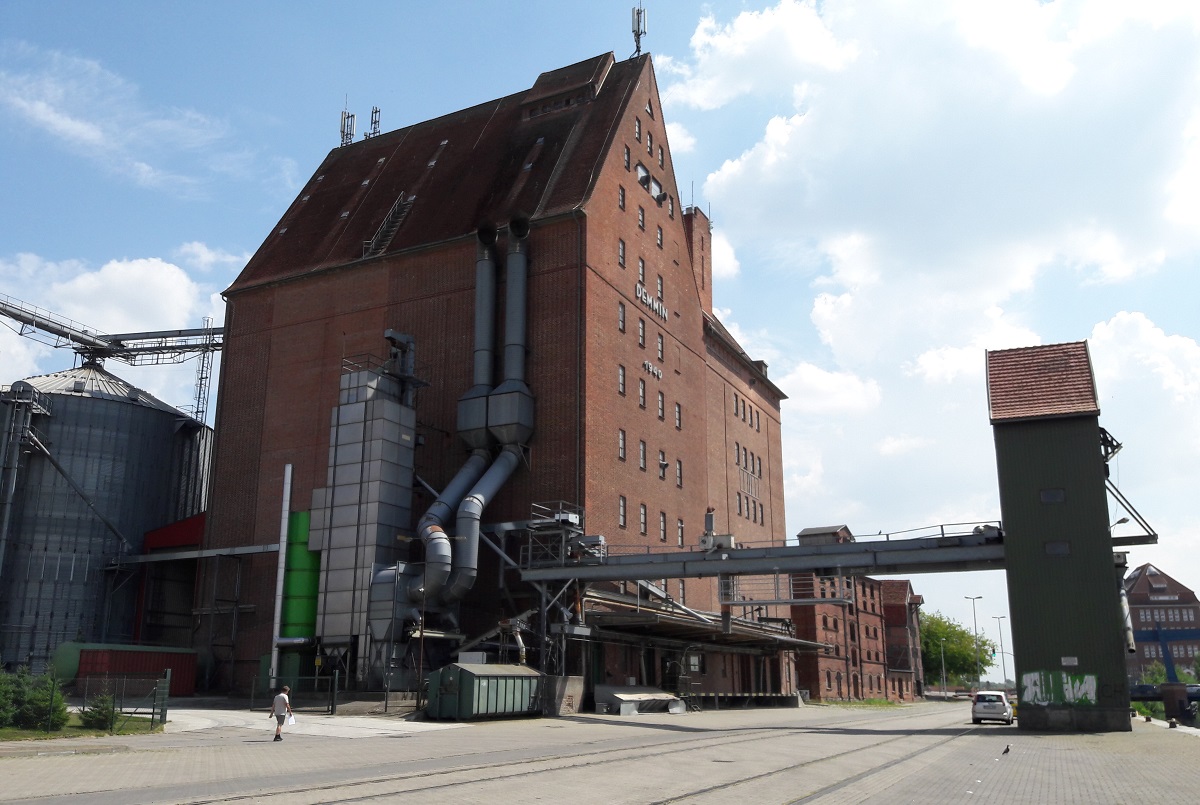
Demmin’s past as an active city in the Hanseatic League was created on the trade that took place on the river Peene. Today, you can still see buildings on the city’s harbor that, although not chronologically dating back to the Hanseatic period, at least stand as examples of river trade.
Along the streets Am Bollwerk and Am Hanseufer there are several warehouses. The oldest is the Lübecker Speicher building, which was built around 1820. The Berliner Speicher dates from 1900, while the other buildings were built in the early 1900s.
Between the two streets you can also see the Kahldenbrücke (Baumannstraße) bridge, which crosses the Peene. The bridge is a fine example of a drawbridge, and there was already a bridge here at the now historic gate, Kahldentor, in the 17th century. The current bridge was constructed 1998-2000.
Haus Demmin is the name of a Pomeranian castle ruin strategically located at the confluence of the rivers Peene and Tollense on the outskirts of present day Demmin. The ruin stands as one of the oldest preserved secular buildings in Pomerania.
There was already a Slavic defense on this site in the 7th century, while Haus Demmin was founded in 1127. Already the following year, the castle entered the history books, when Bishop Otto von Bamberg met Duke Wartislaw I here during a mission. The core of the castle was a round defensive tower, and external reinforcements were added to the complex. The tower burned in 1631 and was further destroyed by an explosion in 1648.
At the ruin, the Podewils family built a manor in the form of a late classicist mansion. It was in 1840, and the place was a residence until 1945, after which it functioned as a boarding school and school in the GDR years from 1946. The imposing house stood until 1998, when it burned down, so it too stands as a ruin.
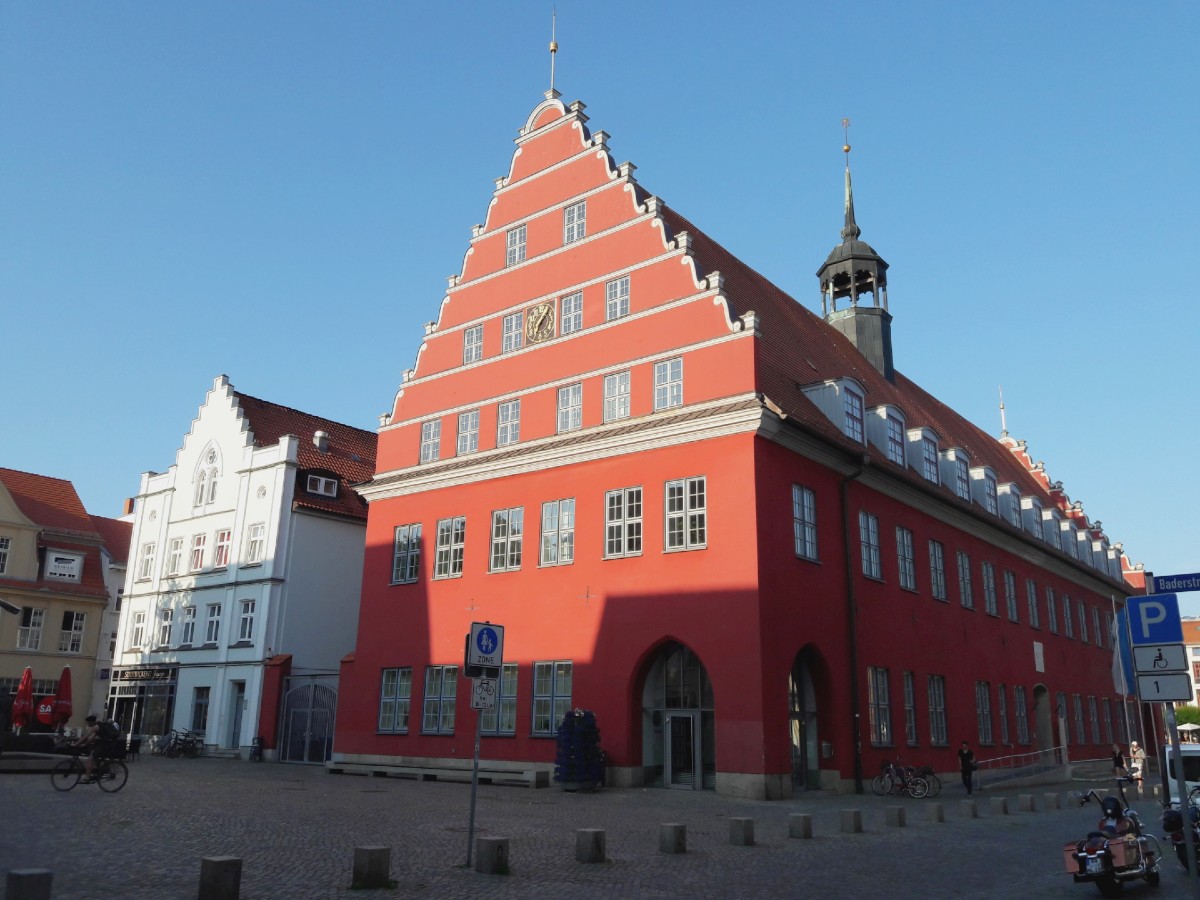
The Hanseatic city of Greifswald by the river Ryck is a cozy and interesting city with everything that belongs to the epitome of a northern German city. Beautiful buildings, impressive churches, a central market square and a town hall with a history from the Hanseatic period are just some of the highlights.
Compared to other northern German Hanseatic cities, Greifswald is a relatively small town, and this gives the opportunity to experience the city on foot at your leisure. There is not far between the sights, which for many is a great experience.
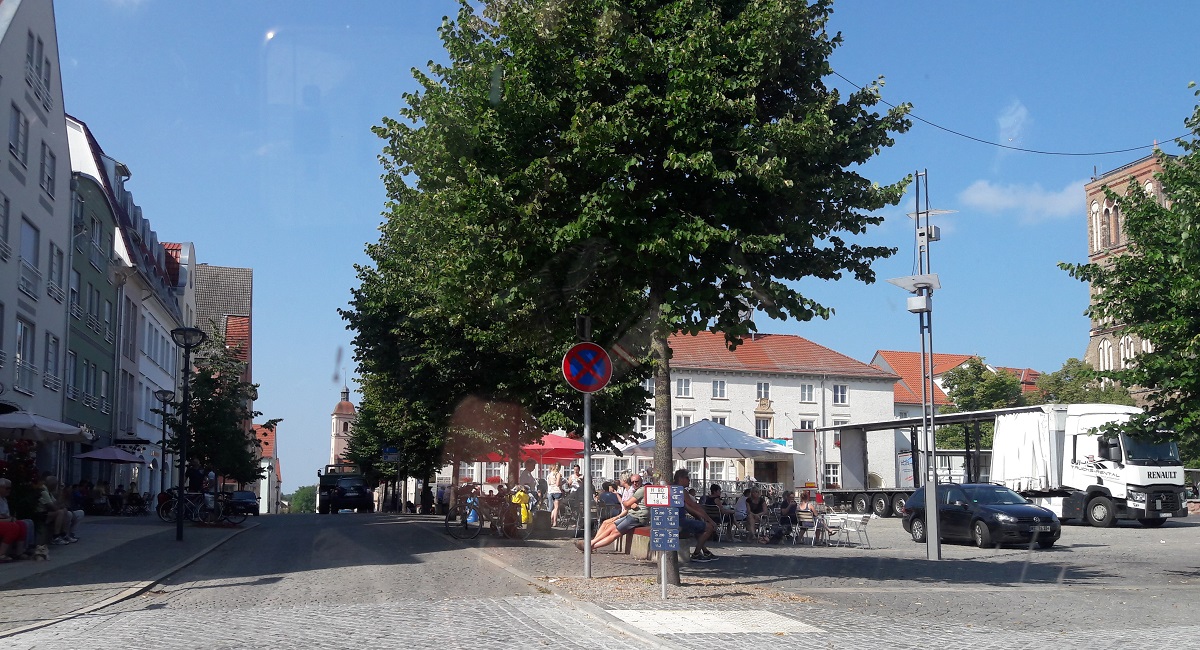
Anklam is the name of one of the smaller North German Hanseatic cities. It is a small town with an exciting history and fine sights, which can be seen on some lovely walks in the town centre. The best place to start is the main square Markt.
There are some large churches and fine houses in the city streets. The modern history goes back to the 13th century, when trade flourished in the region, and as a visible result, Anklam’s harbor was built. Fish and other goods made the economy grow, and there was corresponding growth in the city.
Stralsund is a Hanseatic city and one of the region’s larger cities with a cozy old quarter with many attractions. Stralsund’s rich history as a flourishing Hanseatic city can be seen everywhere. Merchant buildings line the streets between the city’s three large churches and other public buildings that were constructed as symbols of the city’s wealth in the medieval Hanseatic period.
The many small streets are atmospheric as if from a bygone era, and you quickly discover why the city center has made it onto UNESCO’s list of world cultural heritage. Squares and the area by the water are other very lively places where larger events often take place.
Stralsund’s location with water on all sides offers opportunities for many wonderful activities, either directly on the water or at one of the city’s distinguished maritime museums with the modern aquarium, Ozeaneum, as the spearhead.
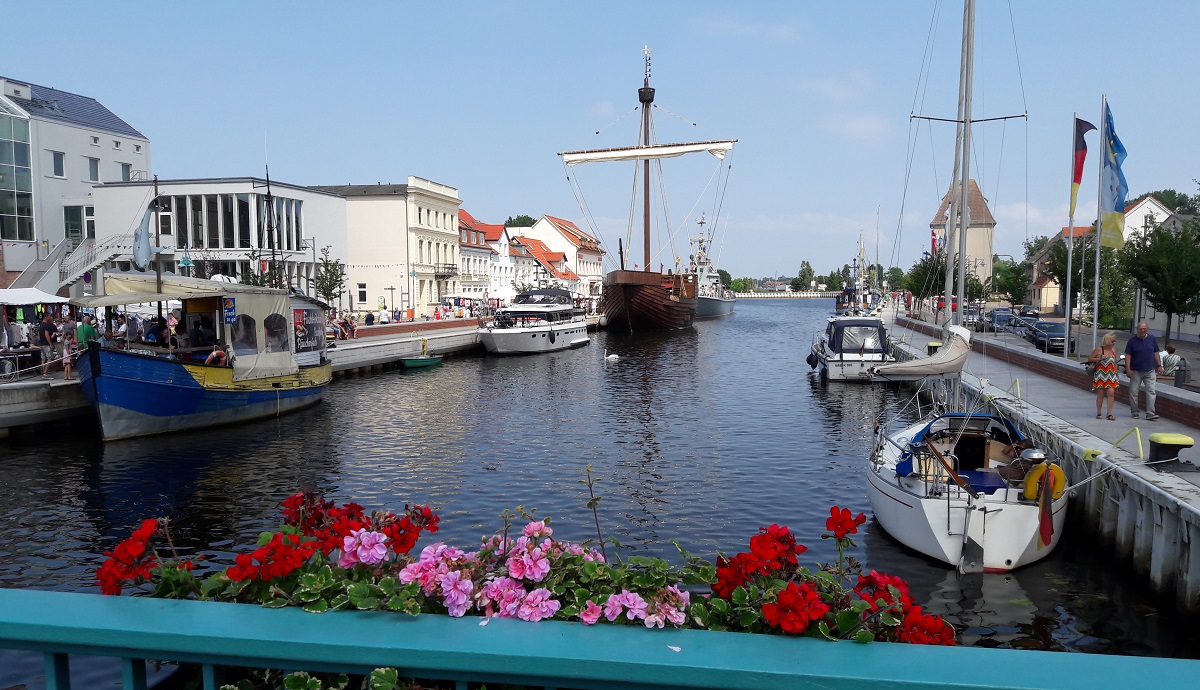
Ueckermünde is a harbor town at the mouth of the river Uecker, and the combination of the maritime with a very pleasant town center makes a trip here a pleasant experience in northeastern Germany.
Historically, Ueckermünde was first mentioned in 1178 and it was a fishing town. In the following centuries, the city grew due to trade and its favorable location on the Uecker, and several larger buildings were constructed like the fortified castle that the dukes of Pomerania had built, churches and fortifications.
Today, many people visit Ueckermünde to take a walk around the charming harbor along the Uecker (Altes Bollwerk, Neues Bollwerk), which is close to the old town. Here is a market and several different options for sailing trips or visits to ships during the season.
However, you should include a trip in the city center northwest of the harbour. Here you can see the preserved parts of the ducal palace (Am Rathaus) from the 1540s, which is today the seat of the city’s administration, and the Marienkirche church (Ueckerstraße 86), which is particularly worth seeing.
Marienkirche in its current version was built in the years 1752-1766 in baroque and rococo architecture; however, with a neo-Gothic tower from 1866. It is the interior of the church that is something special. The interior with balconies and the painted flat wooden ceiling create a special space and atmosphere.
Finally, you can walk about a hundred meters further north-west from the church, where the town square named Markt is located. Markt is surrounded by a number of fine buildings, and there is outdoor seating at the square during the season and a fountain.
The Historisch-Technisches Museum Peenemünde is a museum that was established in 1991 in the former power plant building of the city of Peenemünde. The museum’s primary focus is the German rocket tests and construction that took place around Peenemünde in the period 1936-1945. It was here that Wernher von Braun headed the Nazi rocket program, probably best known for the V1 and V2 rockets.
Wernher von Braun experimented with rockets for many years, and after the end of World War II he continued to work for the United States. His efforts and knowledge ended up being the Saturn V rockets that carried American astronauts into space and to the Moon.
The test facilities at Peenemünde were made possible in 1936 when the Ministry of Aviation in Germany bought the northern part of the island of Usedom from the town of Wolgast for 750,000 reichsmarks. After this, an extensive complex of buildings was built, where rockets and so on were tested. Peenemünde was bombed several times during World War II, with the first raid on the 17th and 18th August 1943.
At the museum, there are also other depictions and objects exhibited than von Braun’s rockets. These include, for example, a corvette from the GDR’s Volksmarine, Russian MIG aircraft and railway equipment. All in all, the place is an experience for both those interested in history and technology.
Lomonossowallee 58, Greifswald
moewencenter.de
Rigaer Straße 9, Greifswald
oez-greifswald.com
Lange Straße, Greifswald
Markt, Rudolf-Breitscheid-Straße, Clara-Zetkin-Straße
HanseDom
Grünhufer Bogen 18-20, Stralsund
hansedom.de
Heimattierpark
Anlagen 3, Greifswald
tierpark-greifswald.de
Ozeaneum
Hafenstraße 11, Stralsund
ozeaneum.de
Demmin’s history dates back to scattered settlements in the area around the 7th century. By the future Demmin, a castle was established and a city gradually grew. Mission trips were made several times, the most important being Otto von Bamberg’s in 1128. Later in the 1100s, Demmin was chosen as the residence city by the local dukes. In the 13th century, a new city plan with grid-shaped street network was implemented, and the city also got a city wall with five gates around it.
In the years around 1240, Demmin obtained market town rights, as exemplified by other enterprising commercial towns, and the trade flourished in the town, which served as a transhipment site for goods; this happened at the river port made possible by the River Peene. In 1283, Demmin joined the Hanseatic League. In 1320, the Pomeranian dukes granted the city freedom of duty, and through the 1300s-1400s Demmin formed alliances with the Hanseatic cities of Anklam, Greifswald and Stralsund.
In 1407 parts of the city burned and a new fire in 1495 destroyed almost all of Demmin. However, the city rose again, and in the mid-1500s, Demmin’s defensive walls were expanded. Over the following centuries, several wars raged, and Demmin was occupied by Prussians, Russians and Swedes alike; during battles, the city was hit by a wildfire in 1676. With the Peace in Hamburg in 1762, Peene became the border between Prussia and Swedish Pomerania.
In 1815, all of Pomerania became subject to Prussia, and Demmin came administratively under Stettin. In 1877 the railway to the city came on the line between Berlin and Stralsund, and it was a period of great industrial development in the city.
The 20th century was marked by two world wars, which were completed by the Soviet Red Army inmarch in the city on April 30-1. May 1945. Demmin became part of the GDR, rebuilding the modern core of the city after the destruction of World War II.
During the GDR, the city’s population grew to about 17,000 inhabitants, which was the highest in Demmin’s history. In 1994, the city was officially renamed Hansestadt, which is known as Hansestadt Demmin today.
Overview of Demmin
The town of Demmin is one of the Hanseatic cities of Mecklenburg-Vorpommern, and there are several sights in the city from its history as a fortified commercial center. Today, more than 10,000 inhabitants live in Demmin, and the central square is Markt.
Markt is the market square in the city, and it is a good starting point for a walk in the streets. Do enjoy the elegant city hall before you continue to the great St. Bartholomew’s Church and the maritime environment at the previously very busy river port, which was the reason for much of the development of Demmin.
About the upcoming Demmin travel guide
About the travel guide
The Demmin travel guide gives you an overview of the sights and activities of the German city. Read about top sights and other sights, and get a tour guide with tour suggestions and detailed descriptions of all the city’s most important churches, monuments, mansions, museums, etc.
Demmin is waiting for you, and at vamados.com you can also find cheap flights and great deals on hotels for your trip. You just select your travel dates and then you get flight and accommodation suggestions in and around the city.
Read more about Demmin and Germany
Buy the travel guide
Click the “Add to Cart” button to purchase the travel guide. After that you will come to the payment, where you enter the purchase and payment information. Upon payment of the travel guide, you will immediately receive a receipt with a link to download your purchase. You can download the travel guide immediately or use the download link in the email later.
Use the travel guide
When you buy the travel guide to Demmin you get the book online so you can have it on your phone, tablet or computer – and of course you can choose to print it. Use the maps and tour suggestions and you will have a good and content-rich journey.
Market Square • City Hall • St Bartholomew’s Church • The Old Harbor
Overview of Demmin
The town of Demmin is one of the Hanseatic cities of Mecklenburg-Vorpommern, and there are several sights in the city from its history as a fortified commercial center. Today, more than 10,000 inhabitants live in Demmin, and the central square is Markt.
Markt is the market square in the city, and it is a good starting point for a walk in the streets. Do enjoy the elegant city hall before you continue to the great St. Bartholomew’s Church and the maritime environment at the previously very busy river port, which was the reason for much of the development of Demmin.
About the upcoming Demmin travel guide
About the travel guide
The Demmin travel guide gives you an overview of the sights and activities of the German city. Read about top sights and other sights, and get a tour guide with tour suggestions and detailed descriptions of all the city’s most important churches, monuments, mansions, museums, etc.
Demmin is waiting for you, and at vamados.com you can also find cheap flights and great deals on hotels for your trip. You just select your travel dates and then you get flight and accommodation suggestions in and around the city.

Luisentor is Demmin’s only remaining city gate from the city’s medieval fortifications. The 31 meter high gate was built in the 13th century at the same time as the city walls, which formed the defense of the city centre. During the period spanning 1768-1895, the gate also functioned as a prison.
The gate was called Kuhtor until 1821, and it was Demmin’s defense gate to the east and at the same time the most important of the city’s gates, since there was no natural defense in the form of the surrounding waterways in this direction.
Demmin’s medieval fortification consisted of a wall around the city. There were a total of 27 gates and towers along the wall, and in addition to the eastern Kuhtor, the gates were named Frauentor, Schloßtor, Fischerpforte, Kahldentor, Holstentor and Mentzerpforte in that order clockwise from the Kuhtor.

Demmin’s past as an active city in the Hanseatic League was created on the trade that took place on the river Peene. Today, you can still see buildings on the city’s harbor that, although not chronologically dating back to the Hanseatic period, at least stand as examples of river trade.
Along the streets Am Bollwerk and Am Hanseufer there are several warehouses. The oldest is the Lübecker Speicher building, which was built around 1820. The Berliner Speicher dates from 1900, while the other buildings were built in the early 1900s.
Between the two streets you can also see the Kahldenbrücke (Baumannstraße) bridge, which crosses the Peene. The bridge is a fine example of a drawbridge, and there was already a bridge here at the now historic gate, Kahldentor, in the 17th century. The current bridge was constructed 1998-2000.
Haus Demmin is the name of a Pomeranian castle ruin strategically located at the confluence of the rivers Peene and Tollense on the outskirts of present day Demmin. The ruin stands as one of the oldest preserved secular buildings in Pomerania.
There was already a Slavic defense on this site in the 7th century, while Haus Demmin was founded in 1127. Already the following year, the castle entered the history books, when Bishop Otto von Bamberg met Duke Wartislaw I here during a mission. The core of the castle was a round defensive tower, and external reinforcements were added to the complex. The tower burned in 1631 and was further destroyed by an explosion in 1648.
At the ruin, the Podewils family built a manor in the form of a late classicist mansion. It was in 1840, and the place was a residence until 1945, after which it functioned as a boarding school and school in the GDR years from 1946. The imposing house stood until 1998, when it burned down, so it too stands as a ruin.
Similar to Demmin Travel Guide